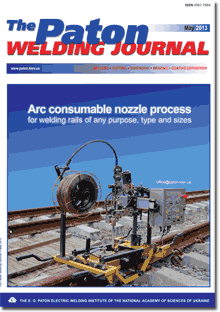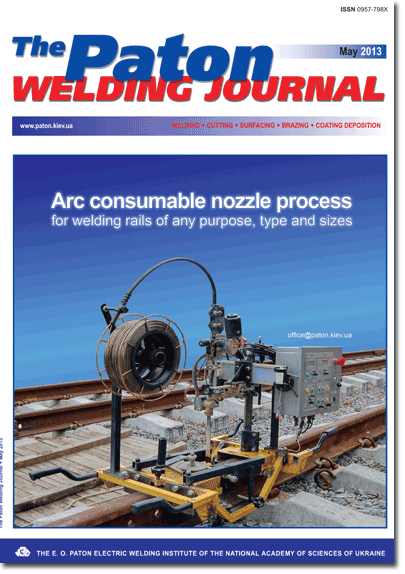| 2013 №05 (01) | 2013 №05 (03) |

The Paton Welding Journal, 2013, #5, 14-20 pages
INFLUENCE OF DIFFUSIBLE HYDROGEN ON DELAYED CRACKING RESISTANCE OF HIGH-CARBON STEEL WELDED JOINTS
A.A. GAJVORONSKY
E.O. Paton Electric Welding Institute, NASU, Kiev, Ukraine
Abstract
Influence of diffusible hydrogen in deposited metal on the change of resistance to and nature of delayed fracture of HAZ metal in welded joints of high-strength wheel steel of grade 2 with 0.58 wt.% C was studied. «Pencil» method was used to determine diffusible hydrogen content in the deposited metal in CO2 welding by PP-AN180MN flux-cored wire, the amount of which can vary in the range from 0.3 up to 2.2 cm3/100 g. At testing by the implant method the influence of diffusible hydrogen on the change of critical stress values at delayed fracture of wheel steel joints was evaluated. Scanning electron microscopy methods were used to study the influence of diffusible hydrogen on the nature of HAZ metal fracture; characteristic fracture zones and structural component parameters were determined. It is established that at diffusible hydrogen content in the deposited metal on the level of 0.3 cmσ0.23σ0.2/100 g delayed fracture resistance of the joints is the highest, and depending on structural condition of metal of HAZ overheated zone critical fracture stresses are equal to (0.35-0.45)σ0.2. Fracture occurs predominantly in the brittle mode along the boundaries and through the grain body, fraction of tough structural component is not more than 20 %. At increase of diffusible hydrogen content HAZ metal becomes brittle and delayed fracture resistance decreases. The most abrupt drop of critical stress characteristics to 0.1σ0.2 value is characteristic for the metal of HAZ with martensite-bainite structure, which has 70 % of martensite. 13 Ref., 2 Tables, 6 Figures.
Keywords: arc welding, diffusible hydrogen, wheel steel, delayed fracture, HAZ, structure
Received: 06.03.13
Published: 28.05.13
References
1. Kozlov, R.A. (1969) Hydrogen in welding of hull steels. Leningrad: Sudostroenie.
2. Makarov, E.L. (1981) Cold cracks in welding of alloyed steels. Moscow: Mashinostroenie.
3. Hrivnak, I. (1984) Weldability of steels. Moscow: Mashinostroenie.
4. Kasatkin, O.G. (1994) Peculiarities of hydrogen embrittlement of high strength steels in welding. Avtomatich. Svarka, 1, 3-7.
5. Pokhodnya, I.K., Shvachko, I.V. (1997) Physical nature of hydrogen induced cold cracks in welded joints of structural steels. Ibid., 5, 3-12.
6. Makhnenko, V.I. (2006) Resource of safety service of welded joints and assemblies of current structures. Kiev: Naukova Dumka.
7. Shvachko, I.V., Ignatenko, A.V. (2007) Model of transportation of hydrogen with dislocations. The Paton Welding J., 2, 24-26.
8. Ignatenko, A.V., Pokhodnya, I.K., Paltsevich, A.P. et al. (2012) Dislocation model of hydrogen-enhanced localizing of plasticity in metals with bcc lattice. Ibid., 3, 15-19.
9. Pokhodnya, I.K., Paltsevich, A.P. (1980) Chromatographic method for determination of diffusion hydrogen content in welded joints. Avtomatich. Svarka, 1, 37-39.
10. Makhnenko, V.I., Korolyova, T.V., Lavrinets, I.G. (2002) Effect of microstructural transformations on redistribution of hydrogen in fusion welding of structural steels. The Paton Welding J., 2, 6-13.
11. Kiselyov, S.N., Voronin, N.N., Kuzmina, G.D. et al. (2000) Investigation of thermal processes and structure formation in twin-arc surfacing of railway wheels on the base of computer modeling. Svarochn. Proizvodstvo, 3, 3-8.
12. Gajvoronsky, A.A., Poznyakov, V.D., Sarzhevsky, V.A. et al. (2010) Influence of thermodeformational cycle of hardfacing on the structure and properties of railway wheels at their reconditioning. The Paton Welding J., 5, 15-18.
13. Gajvoronsky, A.A., Poznyakov, V.D., Markashova, L.I. et al. (2012) Influence of deposited metal composition on structure and mechanical properties of reconditioned railway wheels. Ibid., 8, 16-22.
Suggested Citation
A.A. GAJVORONSKY (2013) INFLUENCE OF DIFFUSIBLE HYDROGEN ON DELAYED CRACKING RESISTANCE OF HIGH-CARBON STEEL WELDED JOINTS. The Paton Welding J., 05, 14-20.The cost of subscription/purchase order journals or individual articles
| Journal/Currency | Annual Set | 1 issue printed |
1 issue |
one article |
| TPWJ/USD | 384 $ | 32 $ | 26 $ | 13 $ |
| TPWJ/EUR | 348 € | 29 € | 24 € | 12 € |
| TPWJ/UAH | 7200 UAH | 600 UAH | 600 UAH | 280 UAH |
| AS/UAH | 1800 UAH | 300 UAH | 300 UAH | 150 UAH |
| AS/USD | 192 $ | 32 $ | 26 $ | 13 $ |
| AS/EUR | 180 € | 30 € | 25 € | 12 € |
| SEM/UAH | 1200 UAH | 300 UAH | 300 UAH | 150 UAH |
| SEM/USD | 128 $ | 32 $ | 26 $ | 13 $ |
| SEM/EUR | 120 € | 30 € | 25 € | 12 € |
| TDNK/UAH | 1200 UAH | 300 UAH | 300 UAH | 150 UAH |
| TDNK/USD | 128 $ | 32 $ | 26 $ | 13 $ |
| TDNK/EUR | 120 € | 30 € | 25 € | 15 € |
AS = «Automatic Welding» - 6 issues per year;
TPWJ = «PATON WELDING JOURNAL» - 12 issues per year;
SEM = «Electrometallurgy Today» - 4 issues per year;
TDNK = «Technical Diagnostics and Non-Destructive Testing» - 4 issues per year.


